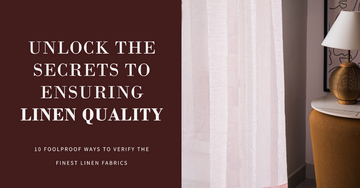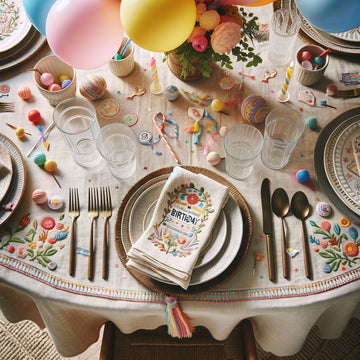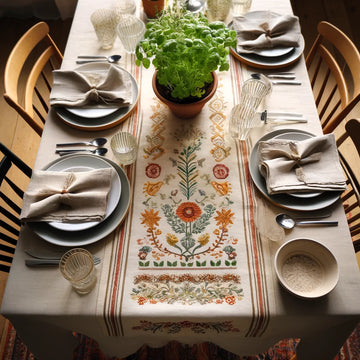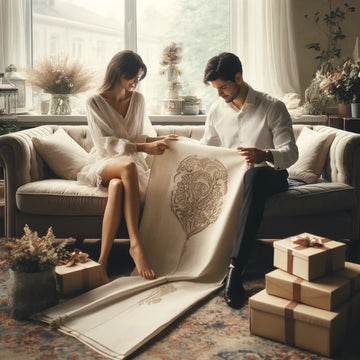Linen Quality Verification Secrets
As you embark on your quest for the finest linen fabrics, armed with these ten foolproof ways to verify Linen, remember that investing in Linen is one of the best decisions you will take.
Table Of Contents:
|
Introduction |
|---|
|
The timeless allure of linen fabrics |
|
1. Feel the Difference: Texture Matters |
|
2. Observe the Threads: Look for Quality Weaving |
|
3. Embrace the Wrinkles: Linen's Signature Charm |
|
4. Check the Density: Weight Matters |
|
5. Investigate the Hue: Natural Colors Prevail |
|
6. Sensitivity to Dyes and Colors |
|
7. Moisture Absorption Test: Linen’s Hygroscopic Nature |
|
8. Natural Fibre Resilience: Linen's Tenacity |
|
9. Consider the Source: Responsible Sourcing |
|
10. The Burn Test: An Age-Old Authenticity Check |
|
Conclusion |
Introduction
Welcome to Blue Flower Co., your ultimate destination for discovering the most exquisite and high-quality linen fabrics on the market! If you're someone who values craftsmanship and sophistication, then linen should undoubtedly be your top choice. At Blue Flower Co., we take immense pride in offering a diverse collection of linen fabrics that epitomize elegance and comfort.
The Timeless Allure of Linen Fabrics
Linen has an illustrious history dating back thousands of years, and its timeless appeal still captivates people today. Derived from the fibers of the flax plant, linen is renowned for its smooth, lustrous texture and unique ability to keep you cool in warm weather. It is a fabric of luxury and versatility, cherished by designers, artisans, and fashion enthusiasts alike.
We understand the allure of linen and its eco-friendly nature. We take extra care in sourcing and manufacturing our linen fabrics to ensure that they meet the highest quality standards. When you choose linen from Blue Flower Co., you're not just acquiring a fabric; you're indulging in an experience of refinement and elegance.
1. Price Point: You Get What You Pay For
While it's not an infallible method, considering the price is an essential step in assessing linen's authenticity. Genuine, high-quality linen comes from a labor-intensive process, from harvesting the flax plant to the final weaving. If a deal seems too good to be true, it's worth questioning the linen's genuineness. True linen tends to be more expensive than its synthetic or blended counterparts.
2. Yarn Thickness: Variations Are Key
Upon closer inspection, you should notice subtle variations in the yarn thickness throughout the linen fabric. This is because genuine linen is made from natural flax fibers, and these slight inconsistencies are typical and add to its unique charm. Uniformity in thread thickness might indicate a blend or synthetic replication.
3. Embrace the Wrinkles: Linen's Signature Charm
In the enchanting world of linen, wrinkles are not to be shunned or meticulously ironed away; instead, they are to be embraced wholeheartedly. Linen's slight propensity to wrinkle is not a flaw but rather an inherent and cherished part of its distinctive character. It is a testament to the authenticity and pureness of this remarkable fabric, representing its organic nature and eco-friendly essence.
As you hold our high-quality linen in your hands, you'll notice the gentle creases and folds that adorn the fabric. Rather than detracting from its beauty, these soft wrinkles enhance the fabric's allure, creating an exquisite texture that is uniquely linen. With every wear and use, linen develops a graceful drape, lending a touch of timeless charm to your creations.
"Wrinkles are the soul of linen; they tell stories of a fabric that's lived and loved."
4. Flexibility: Linen's Graceful Aging Process
One of linen's hallmark features is its ability to become softer and more pliable with each wash and wear. If you're testing a sample or have purchased a small piece, repeatedly fold and manipulate the fabric.
Genuine linen should respond by softening slightly, hinting at its potential to age gracefully. Synthetic fibers will often remain rigid and unchanged.
5. Assess the Slubs: Imperfections are Perfections
Linen, being a natural fiber, often displays tiny knots or irregularities known as 'slubs' in its weave. These slubs arise from the spinning process when a piece of flax gets twisted with the finer linen strands. Rather than viewing them as defects, they should be seen as indications of authentic, unprocessed linen.
A fabric devoid of these tiny slubs may have undergone excessive processing, which could compromise its durability and feel. When examining your linen, relish in these little quirks that highlight its organic and genuine character.
6. Sensitivity to Dyes and Colors
When it comes to evaluating the quality of linen fabric, the light test is a valuable and revealing technique. Hold the linen fabric against a light source, and you'll gain insight into its transparency. High-quality linen will exhibit a degree of opacity, striking the perfect balance between sheer and solid, making it suitable for various applications, from elegant clothing to exquisite home decor.
If you check out our linen curtain collection, you'll notice how our premium linen exhibits the characteristic muted, earthy tones that speak of authentic linen's natural beauty. Unlike fabrics that display overly bright or sharp colors, our collection embraces the subtle and organic shades that genuine linen adopts when dyed.
7. Moisture Absorption Test: Linen’s Hygroscopic Nature
One of linen's standout features is its remarkable ability to absorb moisture. A quick moisture absorption test can help you ascertain the quality of the fabric. Dab a small amount of water on the linen; high-quality linen should absorb it quickly, leaving the fabric feeling cool but not damp.
This ability not only confirms its genuineness but also indicates its superior cooling qualities.
8. Natural Fibre Resilience: Linen's Tenacity
Linen, being a natural fiber, inherently possesses a unique resilience. One of the ways to verify its quality is to check for its natural stretch and recoil. When pulled taut and then released, genuine linen should bounce back with minimal distortion. This elasticity reflects the fabric's purity and superior craftsmanship, indicating its durability and resistance against wear and tear.
KNOW MORE:- Master the Art of Table Linen: Your Ultimate Buying Guide for Perfect Table Settings
9. Consider the Source: Responsible Sourcing
Responsible sourcing is more than a buzzword; it is the cornerstone of our philosophy. We believe that understanding the source of our linen is integral to delivering a product that aligns with our values and meets the highest standards of quality and integrity.
Our linen fibers are carefully made from imported Belgian flax, spun into Linen yarn in West Bengal (India), yarn is spun into fabric in Bangalore (India) & finally hand-made by our artisans in New Delhi (India). We ensure that every step of the process adheres to ethical principles and supports local communities.
10. The Burn Test: An Age-Old Authenticity Check
While this may sound a tad dramatic, the burn test is a traditional method to verify the authenticity of fabrics. When a small strand of linen is burnt, it should have a herbaceous scent, akin to burning grass, and form a powdery ash. The quick, blue flame and the nature of the ash are indicators of the fabric's purity.
Synthetic fibers, on the other hand, will melt and often give off a plastic-like odor. Remember, this test is best done with caution and outside your home for safety - while conducting this test, always exercise caution and safety.
Conclusion
As you embark on your quest for the finest linen fabrics, armed with these ten foolproof ways, remember that linen is not just a fabric; it's a work of art. We celebrate the beauty, sophistication, and eco-friendliness of linen, curating a collection that represents the epitome of quality.
Indulge in the allure of linen and elevate your creative projects with your favorite premium linen fabrics. Our commitment to sustainability, craftsmanship, and excellence ensures that you receive nothing but the best.
FAQs
Q: What makes linen a preferred fabric choice?
A: Linen is cherished for its exceptional breathability, durability, and natural luster. Its ability to keep you cool in hot weather and warm in colder temperatures makes it ideal for various products, from clothing to bedding.
Q: Is linen environmentally friendly?
A: Yes, linen is an eco-friendly fabric. Flax, the plant from which linen is derived, requires less water and fewer pesticides compared to other crops like cotton. Linen is biodegradable and has a smaller environmental footprint.
Q: Can I machine wash linen products?
A: Yes, most linen items can be machine washed. However, always check the manufacturer's care instructions to ensure proper cleaning and maintenance.
Q: Does linen wrinkle easily?
A: Linen is known for its natural tendency to wrinkle. Embrace the wrinkles as part of linen's charm, or choose stonewashed linen for a more relaxed, wrinkle-resistant appearance.
Q: How do I store linen items properly?
A: Store linen products in a cool, dry place away from direct sunlight to prevent fading and discoloration. Avoid using plastic bags for long-term storage, as linen requires proper air circulation.
Q: Can I use linen year-round?
A: Yes, linen is versatile and suitable for all seasons. Lightweight linen is perfect for warm weather, while heavier linen keeps you cozy during the colder months.







